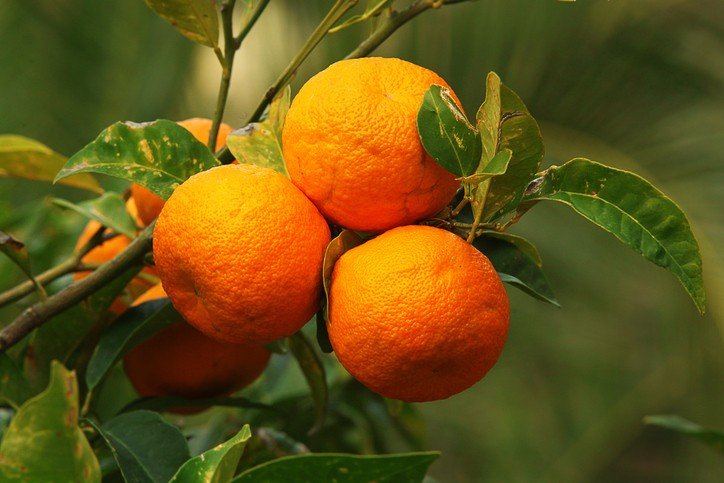Citrus x aurantium
BITTERORANGE
Englische Bezeichnung: Bitter Orange
Spanische Bezeichnung: Naranjo Amargo
Familie
Rautengewächse (Rutaceae)
Verwendbare Teile:
Frucht, Schale, Blüten & Blätter
Hauptbestandteile:
Mineralstoffe: Kalium
Vitamine: C
Sekundäre Pflanzenstoffe: Bitter schmeckende Glykoside (Neohesperidin und Naringin) sowie geschmacklose Glykoside wie Hesperidin und Rutin sowie höher methoxylierte Flavonoide wie Sinensetin, Nobiletin und Tangeretin. Weitere Bestandteile sind: Limonoide, Cumarine (auch Furanocumarine), grössere Mengen an Pektin
Ernte-Hinweise:
Zwei wichtige Eigenschaften für die Reife: die Frucht wächst nicht mehr und sie verfärbt sich. Gleichzeitig gibt sie einem Druck auf die Schale leicht nach.
Wenn man Zitrusfrüchte ernten will, muss man eine Schere zur Hand nehmen. Da die Früchte meist fest am Baum sitzen, schneidet man sie knapp einen Zentimeter oberhalb des Stielansatzes an der Frucht ab. Wenn die Frucht abgerissen wird, droht eine Verletzung entweder des fruchttragenden Zweiges oder der Schale.
Verwendung:
Frucht: Marmelade, Sirup, Cocktails
Schale & Blätter: Tee, ätherische Öle, Tinkturen
Die ursprüngliche Herkunft der Zitruspflanzen ist Südostasien.
Da Zitrus eine Jahrtausende alte Kulturpflanze ist, die gezüchtet und veredelt wurde und wird, gibt es heute keine bekannte Wildform der Urfrucht mehr. Jedoch gibt es ein sehr breites Spektrum an verschiedensten Zitrusfrüchten, einschließlich der Bitterorange.
Sie ist aus einer Kreuzung von Mandarine (Citrus reticulata) und Pampelmuse (Citrus maxima) entstanden.
Die Bitterorangenschalen werden wegen der verdauungsanregenden Bitterstoffe bei Appetitlosigkeit und Verdauungsbeschwerden eingesetzt. Die Lebensmittelindustrie stellt aus den Schalen Orangeat und Orangenmarmelade her. Schalen und Saft sind zudem Zutaten für den Likör Curaçao und die italienische Bitterorangenlimonade Aranciata Amara.
Aus der Bitterorange lassen sich dreierlei ätherische Öle gewinnen. Die grünen Blätter, Zweige und unreifen Früchte enthalten das sehr aromatisch duftende Petitgrain. Aus den Schalen reifer Früchte lässt sich das Bitterorangenöl gewinnen, das in vielen zitronigen Duftwässern enthalten ist.
Family
Rhombus family (Rutaceae)
Usable parts:
Fruit, peel, flowers & leaves
Main components:
Minerals: Potassium
Vitamins: C
Secondary plant substances: Bitter-tasting glycosides (neohesperidin and naringin) and flavourless glycosides such as hesperidin and rutin as well as higher methoxylated flavonoids such as sinensetin, nobiletin and tangeretin. Other components are: Limonoids, coumarins (also furanocoumarins), large amounts of pectin
Harvesting guideline:
Two important characteristics for ripeness: the fruit stops growing and it discolours. At the same time, it yields slightly to pressure on the peel.
If you want to harvest citrus fruits, you need to take a pair of scissors. As the fruit is usually firmly attached to the tree, cut it off just under one centimetre above the base of the stalk on the fruit. If the fruit is torn off, there is a risk of damaging either the fruit-bearing branch or the skin.
Use:
Fruit: Jam, syrup, cocktails
Peel & leaves: tea, essential oils, tinctures
The original origin of citrus plants is South East Asia.
As citrus is a cultivated plant that is thousands of years old and has been cultivated and grafted, there is no known wild form of the original fruit today. However, there is a very wide range of different citrus fruits, including the bitter orange.
It originated from a cross between the mandarin (Citrus reticulata) and the grapefruit (Citrus maxima).
Bitter orange peel is used to treat loss of appetite and indigestion due to its digestive bitter substances. The food industry produces candied orange peel and orange marmalade from the peel. The peel and juice are also ingredients for the liqueur Curaçao and the Italian bitter orange lemonade Aranciata Amara.
Three types of essential oils can be extracted from the bitter orange. The green leaves, twigs and unripe fruit contain the very aromatic petitgrain. Bitter orange oil, which is contained in many lemony scented waters, can be extracted from the peel of ripe fruit.
Familia
Familia Rhombus (Rutaceae)
Partes utilizables:
Frutas, cáscaras, flores y hojas
Componentes principales
Minerales: Potasio
Vitaminas: C
Sustancias vegetales secundarias: Glucósidos de sabor amargo (neohesperidina y naringina) y glucósidos sin sabor como la hesperidina y la rutina, así como flavonoides metoxilados superiores como la sinensetina, la nobiletina y la tangeretina. Otros componentes son: Limonoides, cumarinas (también furanocumarinas), grandes cantidades de pectina.
Uso:
Frutas: Mermelada, jarabe, cócteles
Cáscara y hojas: té, aceites esenciales, tinturas







































